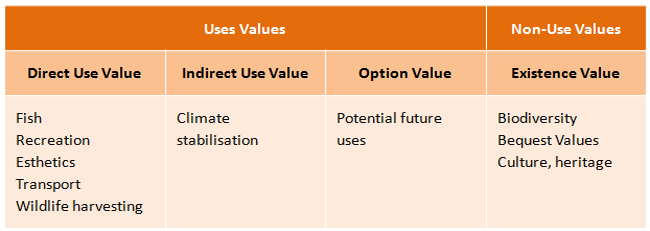3.5 Economic methods

Economic valuation methods seek to measure the trade-offs individuals are willing to make for ecological improvements or to avoid ecological degradation, given the constraints they face.
They are based on the utilitarian concept of Total Economic Value (TEV) of the environment, an expression of the many ways through which people benefit from the environment. As put in Barbier [1997], Total Economic Value distinguishes between use value and non-use values:
- use values involving some interactions between human and Nature
- whereas non-use values do not and rely mostly on its continued existence.
Use values are either:
- direct: e.g. people benefit directly from the use of seashore for recreation
- or indirect: e.g. the regulatory ecological functions of the ocean and their impacts on climate change.
Use values also consider actual uses and potential future uses (option use). The Total Economic Value framework, as applied to the marine and coastal environment, is illustrated in the following table.
Table: Classification of Total Economic Value for Marine Environment (adapted from Barbier et al., 1997)

Tradeoffs people are willing to make is captured through the economic notion of “willingness to pay” (WTP), i.e. the amount of money the people would agree to pay in order to benefit from a given ecological improvement or to avoid some specific ecological degradation, in order to maintain a given level of satisfaction.
Willingness To Pay can be computed through the use of prices for some ecological services. However, most ecological services are unmarketed and specific economic valuation methods are therefore required.
In order to assess Willingness To Pay, one can either carry ad hoc studies, or rely on previous values of Willingness To Pay in the existing literature. Economic valuation methods involving ad hoc studies are classified into revealed preference methods and stated preference methods.
- Revealed preference methods rely on actual individuals’ behaviour to elicit preferences for ecosystem services. Preferences are revealed indirectly, i.e. through the purchase of a market good which is associated with the given ecosystem service. The strength of this group of methods is that they rely on historical data. Their weaknesses are that they only capture use values and do not allow eliciting preferences for changes in ecosystem services beyond the range of historical experience.
- Stated preference methods allow estimating benefits of changes in ecosystem services beyond the range of experience. Their strength is that they capture both use and non-use values. Their weakness is that they are based on intended behaviour, which may differ from what individuals’ would actually do.
These two groups of methods can be combined in order to exploit their contrasting strengths while minimizing their weaknesses.

